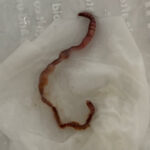
One of our readers has asked about “hard shelled worms about 1/2 to 1 inches long that curl into a tight circle when touched. What are these?” Without a photograph, description of where in the house (or the world!) he found it and any additional physical description, we think he’s writing to us about millipedes.
Read more about brown and black worms that curl up tight here
Millipedes are arthropods, not insects, of the type Myriapoda (meaning “myriad” or ‘uncountably numerous’ feet –“pods.”) As you can easily imagine, the name comes from the up-to-four feet per segment that can be found on their bodies. They all have a single pair of antennae, simple eyes and a mouth on the underside of the head and are known for their shiny hard bodies. All prefer to live in moist areas and feed on decomposing organic material.
Common millipedes are dark worm-like creatures, usually about an inch to an inch and a half in length. Their body is more cylindrical than flat, unlike centipedes. When touched, they will often curl up tightly and move more slowly than their centipede neighbors. It’s not uncommon to see multiple millipedes travel indoors shortly after a rainstorm.
Because the reader provided an estimated length, we feel confident ruling out his finding as a sow bug (also called the woodlouse, roly-poly, or pillbug), which is brownish-gray in color but usually reaches no more than 3/4 of an inch. They’re commonly lumped in with centipedes and millipedes because they inhabit the same damp organic areas. However, the sow bug is more closely related to crabs, crayfish and lobsters.
Millipedes are called “armyworms,” “wireworms,” “thousand leggers,” and often thought of as worms. They are, like worms, ecologically beneficial as recyclers of organic material and cannot bite or sting. They become very active, and therefore more visible, on warm, damp nights when they crawl into parts of the house, to hide from the dryness of the day ahead. Sealing cracks and gaps where they can enter around windows, doors, and foundation walls is the best defense against having these creatures as roommates. Sweeping or vacuuming them up is the most effective removal strategy. They will go dormant in cold weather and re-emerge from hiding in the spring.
All About Worms is always free, always reader-supported. Your tips via CashApp, Venmo, or Paypal are appreciated! Receipts will come from ISIPP Publishing.
You might also find these guys interesting!


















Are they good to have in soil, or should I remove them?
How to get rid of them
In the house
Are. Hard she’ll worms poison to dogs if eaten